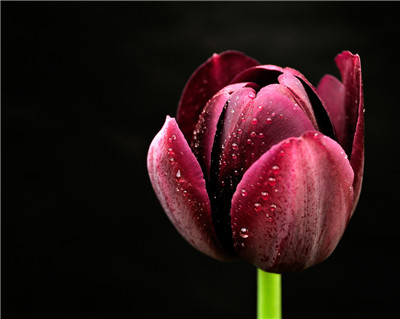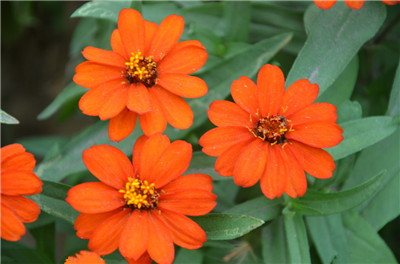Maintenance skills of zinnia
The following key points should be paid attention to in the process of flower cultivation of zinnia:
Xiguang: like warmth, avoid extreme heat, withstand early frost; require fertile and moist soil to significantly reduce the quality of flowering on barren and dry soil.
Temperature: hundred-day grass likes to warm to the sun, can not bear the heat, high temperature and cold, the suitable growth temperature is 18-20 degrees Celsius during the day and 15-16 degrees Celsius at night. It grows especially fast in summer.
Lighting: can be directly used in full sunlight, direct sunlight. If there is not enough sunshine, the plant is easy to grow, the resistance is also weak, and flowering will also be affected.
Moisture: due to the high demand for light, water is easy to evaporate, so it is necessary to maintain proper humidity and can be watered every day in summer.
Planting density: 12 trees per square meter. The hundred-day grass prefers the dry soil environment and avoids environmental waterlogging. In addition to applying an appropriate amount of chicken manure as the base fertilizer for the plant during planting, the dilute liquid fertilizer should also be applied once a week in the vigorous growth stage, which is a crop that likes nitrate nitrogen, so do not apply ammonium fertilizer such as ammonium sulfate and ammonium bicarbonate. The hundred-day grass is full of sunshine and avoid shade in the environment. Keeping the environment ventilated can prevent overgrowth of plants and reduce the occurrence of powdery mildew. Zi Cao likes warmth and is not cold-tolerant. The suitable temperature for its growth is 20 Mel and 30 degrees Celsius, and the plant dies gradually after frost in autumn.

Picture: the maintenance method of zinnia in four seasons
1. Maintenance methods of zinnia in spring
It is suitable to be placed on the balcony facing east, south and west. Zinnia prefers moist soil, but at the same time it is more resistant to drying, fertilizer and barren.
Sowing in late April, basin soil is suitable to choose deep, fertile, well-drained soil. When the seeding seedling has 3 or 4 leaves, it can be transplanted into the pot. Keep the soil moist during sowing time and at the initial stage of transplanting.
At the initial stage of planting, it should be topped for 1 or 2 times to dwarf and produce multiple lateral branches to form a full basin. During the growing period, it is necessary to give sufficient light to the hundred-day grass to make the basin soil moist and apply light fertilizer frequently. It begins to blossom in June and is placed in a place with sufficient light. The potted soil remains moist and proper fertilization is beneficial to the growth and opening of the next round of flowers.
A single flower needs to be cut off in time after failure, otherwise it will affect its appearance; in addition, cutting off the residual flowers can also promote the germination, growth and flowering of new branches in the lower part of Zinnia. If you want to keep the seed, you can cut it off when the flowers are dry.
II. Maintenance methods of zinnia in summer
It is suitable to be placed on the balcony facing east, south and west. Zinnia is not resistant to high temperature, high temperature will slow its growth, reduce flowering, and flowers will not bear seeds. After the temperature rises, it can be moved to a place with bright light or bright light sooner or later to cultivate and watch, keep the basin soil moist and stop fertilizing.
In the middle and late August, after the temperature dropped, it could gradually return to normal growth and flowering. It needs to be moved to culture under light.
Picture: the maintenance method of zinnia in four seasons
Third, the maintenance method of hundred-day grass in autumn
It is suitable to be placed on the balcony facing east, south and west. Autumn is the peak season for the growth and flowering of zinnia. It is necessary to keep the potted soil moist and adequately illuminated, and fertilize properly. The hundred-day grass is not resistant to cold, and it is easy to die of freezing when the temperature drops at the end of autumn. if it is placed on a closed balcony with light, it can prolong the 100-day flowering period and viewing period.
With the decrease of the temperature, the zinnia gradually withered.
Fourth, the maintenance method of zinnia in winter
In winter, the zinnia will die.
The above is the introduction of the maintenance skills of the hundred-day grass in the four seasons. I hope it can be helpful to everyone!
- Prev

Some Experiences in Tulip Cultivation
Tulip flower beautiful, beautiful plant type is a common ornamental plants, this year, into the fresh cut flower market popular, and tulip pedicel long and elegant, is a good flower arrangement materials. Tulip market prospects are broad, cultivation should pay attention to the following
- Next

Culture and maintenance skills of zinnia
Temperature: hundred-day grass likes to warm to the sun, can not bear the heat, high temperature and cold, the suitable growth temperature is 18-20 degrees Celsius during the day and 15-16 degrees Celsius at night. It grows especially fast in summer. Moisture: due to the high demand for light, water is easy to evaporate, and proper humidity should be maintained frequently. It can be watered every day in summer.
Related
- Fuxing push coffee new agricultural production and marketing class: lack of small-scale processing plants
- Jujube rice field leisure farm deep ploughing Yilan for five years to create a space for organic food and play
- Nongyu Farm-A trial of organic papaya for brave women with advanced technology
- Four points for attention in the prevention and control of diseases and insect pests of edible fungi
- How to add nutrient solution to Edible Fungi
- Is there any good way to control edible fungus mites?
- Open Inoculation Technology of Edible Fungi
- Is there any clever way to use fertilizer for edible fungus in winter?
- What agents are used to kill the pathogens of edible fungi in the mushroom shed?
- Rapid drying of Edible Fungi

